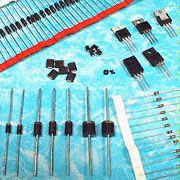We talked about Board Etching Tools in part 1, in this part we will know how to design and make the board
We will begin to design the tracks of any circuit with any graphic programs (Photoshop) or (Pointshop) or even the (Painter) and if the design is ready such as ready-made circuits, then all you need is to print the circle on the transparent paper.
Note: You can directly draw on transparent paper or use the printer, thus we just got the tracks of the electronic circuit on transparent paper .
Now we take the film board and remove the plastic layer that protects the light-sensitive material .
And then put the design that we have prepared and put it on the Board at the the light-sensitive material side .
Now we put the Board design that we made it directly to the UV or neon lamps box and leave it for five minutes .
Note: for who did not use the UV box and replaced it with lamps or Neon Light try to maximize the duration and experiments in order to get the same result .
We should now remove the Film Board from the lights box, you will note that the lines that were not affected by the lights are the circuit board lines and it's almost yellowish green, while the areas that exposed to the lights has become almost like the color of copper .
Note: for who did not use the UV box and replaced it with lamps or Neon Light try to maximize the duration and experiments in order to get the same result .
We should now remove the Film Board from the lights box, you will note that the lines that were not affected by the lights are the circuit board lines and it's almost yellowish green, while the areas that exposed to the lights has become almost like the color of copper .
Now we should prepare the cleaning material by placing 10 grams of sodium hydroxide in a container that has one liter of water and leave it for a quarter of an hour .
Then we put the film board within the solution, and evenly move it until the light affected part is removed .
And then we will show the copper layer, then remove the board from the solution and washed with the water and dry it .
Now this is the most important and most dangerous step where we put the board within the chemical acid to remove the unwanted copper layer .
Warning: Do not directly touch the acid by your hand, you must wear thick rubber gloves and beware of flying material on the body, and keep it out of children reach .
Note: The period of leave the board in the acid is depending on the acid concentration and the type of the used board, you can check it from time to time to make sure that the process is complete .
We now should remove the Board from the acid and wash it with water then dry it, then we check the lines to make sure that there is no thing wrong with it .
Now we will make necessary holes for the electronic parts legs on board .
We now remove the film layer around the holes and places that will be reached by welding material that can be done using copper wire with a little amount of alcohol .
In the end we have a full professional Board with the tracks, and we can install the electronic parts using a welding caustic .













































































